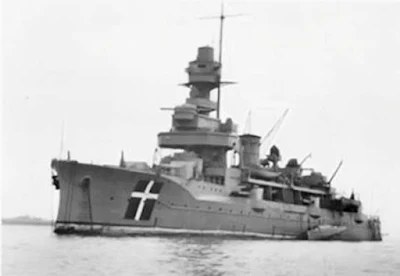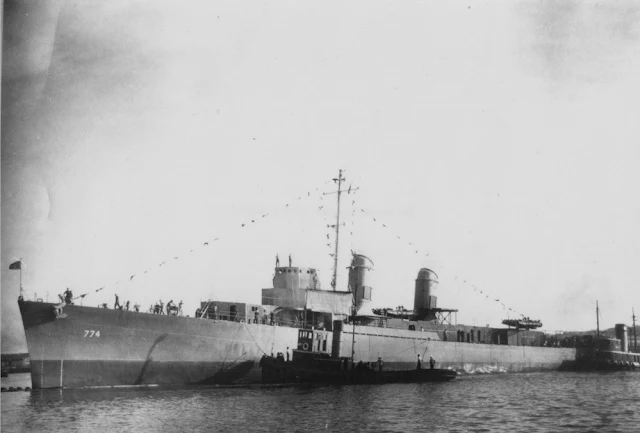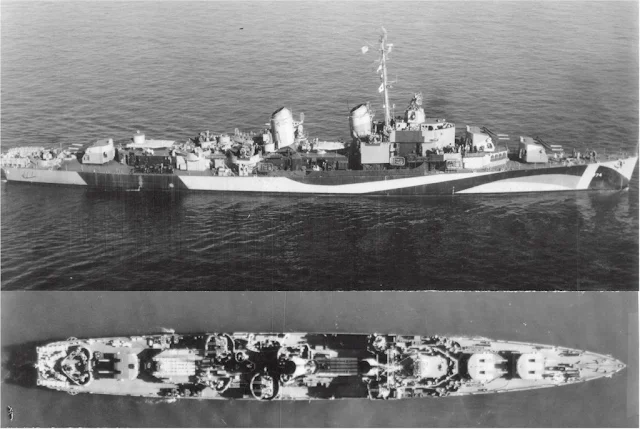 |
| Niels Juel coastal defense ship. Photo taken before she was scuttled off Holbaek in August 1943. |
In the period between the two world wars, the Danish navy (as well as the rest of the Danish military forces) had low priority for the politicians, especially between 1929 and 1942 under Thorvald Stauning. During the first year of the German occupation (1940–1945), the navy assisted the occupying German forces with minesweeping, because of the political demand of keeping the infrastructure (ferry-lines) up and running. The tensions between the German soldiers and the Danish armed forces rose slowly and, on 29 August 1943, they managed to scuttle 32 of its larger ships, while Germany succeeded in seizing 14 of the larger and 50 of the smaller vessels. This was due to a secret order, given directly to the captains by word of mouth by commander of the navy, Vice Admiral A. H. Vedel "to try to flee to the nearest neutral or Nazi-opposed port. If that was not possible, the ship should be scuttled at as deep a location as possible". The Germans later succeeded in raising and refitting 15 of the sunken ships. A number of vessels had been ordered to attempt to escape to Swedish waters, and 13 succeeded. The fleet flagship, Niels Juel, attempted to break out in the Battle of Isefjord but the crew was forced to beach and partly scuttle her. The score for the larger vessels was therefore: 32 vessels were sunk, 2 were in Greenland, 4 reached Sweden, 14 were captured by the Germans. As for the smaller vessels: 9 "patruljekuttere" reached Sweden, 50 others were captured by the Germans. By the autumn of 1944, these ships officially formed a Danish naval flotilla in exile. In September 1943, A. H. Vedel was fired by order of the prime minister Vilhelm Buhl because of his hostile actions towards the Germans.
Danish Navy ships carry the prefix KDM (Kongelige Danske Marine) in Danish, but this is translated to HDMS (Her/His Danish Majesty's Ship) in English.
HDMS Niels Juel was a coastal defense ship of the Royal Danish Navy from 1923 to 1943. She was scuttled by her crew after Luftwaffe attack during the German invasion of Denmark in 1943 and later refloated as the Nordland.
Originally Niels Juel was intended to be an upgraded version of HDMS Peder Skram, a pre-World War I Herluf Trolle-class coastal defense ship. After initially being laid down in 1914 at the Danish Royal Naval Dock Yard, Copenhagen, construction was halted as the original armament orders from the German manufacturer Krupp were delayed by World War I. After changing the armament to Bofors-built guns HDMS Niels Juel was launched on 3 July 1918. After sea trials in early 1923 she was commissioned to the Royal Danish Navy on 23 May and subsequently went on tour, visiting the Faeroe Islands, Bergen, Leith and Gothenburg and South America. She was adopted as the flagship and went on royal tours in June 1926 (Faeroe Islands) and 1930 (Faeroe Islands and Iceland).
Following increasing Danish resistance to German rule and the institution of martial law on 28 August 1943, the German army moved to seize the Danish fleet in Copenhagen harbor, an action codenamed Operation Safari. Anticipating this move, Danish officers managed to scuttle the majority of the Danish fleet to prevent capture. Niels Juel which had spent the summer on exercise in Isefjorden, attempted to break free to Swedish waters, during which she was engaged by the Germans at sea and by air. Having been seriously damaged by aerial bombardment, including five wounded crew members (one of whom died later), the captain, Commander Westermann realized there was little hope of reaching neutral waters and beached the ship near Nykøbing Sjælland. The crew then tried to scuttle the ship. Initial attempts to blow up the ship failed, but the crew successfully flooded the parts of the ship including the magazine, as well as systematically destroying the equipment before evacuation and surrender.
In 1944, the ship was salvaged, renamed Nordland and used by Nazi Germany's Kriegsmarine as a training ship. On 3 May 1945, she was sunk during allied air raids in the Eckernførde inlet. The wreck was later salvaged and on 19 March 1952 was sold for scrap.
Name: HDMS Niels Juel
Namesake: Niels Juel
Builder: Orlogsværftet, Copenhagen
Laid down: 1914
Launched: 3 July 1918
Commissioned: 23 May 1923
Decommissioned: 30 August 1953
Fate: Sold for scrap 1952
Type: Coastal defense ship
Displacement: 3,400 tons
Length: 89.95 m (295 ft 1 in)
Beam: 16.3 m (53 ft 6 in)
Draught: 5.2 m (17 ft 1 in)
Propulsion: 5,500 hp (4,100 kW)
Speed: 16 kn (30 km/h)
Complement: 329
Armament:
10 x 150 mm (5.9 in) guns
4 x 57 mm (2.2 in) anti-aircraft guns
2 x 450 mm (18 in) torpedo tubes
 |
| Danish coastal defense ship Niels Juel, launched 1918, serving 1923-1943. Photographed in 1939 (with effects of 1935-36 refit). |
 |
| The attack on Niels Juel, 29 August 1943. |
 |
| The coast defense ship Niels Juel leaving harbor. |
 |
| Pre-war picture of the gun crew at the Niels Juel's 15cm guns, wearing gas masks. |
 |
| Niels Juel, 1937. |
 |
| The coast defense ship Niels Juel on firing exercise. |
 |
| The coast defense ship Niels Juel. |
 |
| The coast defense ship Niels Juel. |
 |
| The coast defense ship Niels Juel. |
 |
| The coast defense ship Niels Juel. |
 |
| The coast defense ship Niels Juel. |
 |
| The coast defense ship Niels Juel. |
 |
| The Danish Flotilla moored in Holmen after returning from Sweden in May 1945. |
 |
| HDMS Havkatten returns moored in Copenhagen in May 1945 after being in exile in Sweden since 29 August 1943. |
_off_San_Pedro,_California_(USA),_on_11_December_1944_(19-N-75462).jpg)





























